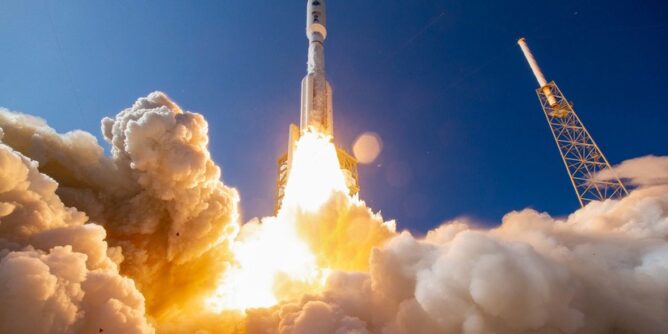
Last summer, the Department of the Air Force’s Space and Missile Systems Center Launch Enterprise requested a RAND Corp. study of the heavy lift launch market.
The RAND study, released today, confirms the heavy lift launch market is unlikely to support more than two U.S. launch providers in the long term, and highlights the short term schedule risks of transitioning to new providers. The National Security Space Launch Phase 2 strategy assumes a limited market and mitigates much of the transition risk. The Department is pleased the RAND report supports the major elements of its National Security Space Launch strategy.
“I thank RAND for the thorough analysis highlighting the risks we balanced in developing the next generation of launch vehicles. We had to take prudent steps to expeditiously end reliance on Russian propulsion systems while maintaining 100 percent mission success for critical National Security Space assets,” said Dr. William Roper, Assistant Secretary of the Air Force for Acquisition, Technology and Logistics. “The Department’s strategy over the last five years is delivering on that mandate.”
“We prioritized ensuring mission success over the risk of only having a single provider for a short period of time,” said Brig. Gen. Donna Shipton, vice commander of the Space and Missile Systems Center. “Given the market projections highlighted in the RAND market study, supporting more than two operational National Security Space launch providers would also decrease each provider’s launch tempo which lowers overall reliability and increases satellite launch costs.”
RAND’s task was to analyze the global space vehicle market focused on NSSL-class vehicles, assess global demand, assess the addressable market, and assess the capacity for U.S. launch service providers in relation to demand from Fiscal Year 2020 through Fiscal Year 2029. RAND’s report makes two main recommendations: “The U.S. Space Force should make prudent preparations for a future with only two U.S. providers of NSS-certified heavy lift launch, at least one of which may have little support from the commercial marketplace; [and] the U.S. Space Force should continue to provide tailored support through 2023 to enable three U.S. providers to continue in or enter the heavy lift launch market.” RAND emphasized that tailored support to three providers does not necessarily mean selecting three providers for the NSS Phase 2 launch service contracts.
“We asked RAND to independently double check the assumptions we used to build our acquisition strategy,” said Col. Robert Bongiovi, director of SMC’s Launch Enterprise. “What we found was that our acquisition strategy encompasses RAND’s recommendations as we are already making prudent preparations for a market that will only sustain two providers with our Phase 2 contract structure.”
The Space and Missile Systems Center, headquartered at Los Angeles Air Force Base in El Segundo, California, is the newly formed U.S. Space Force’s center of acquisition excellence for acquiring and developing military space systems. Its portfolio includes the development of advanced space and launch capability and systems, global positioning systems, military satellite communications, defense meteorological satellites, space launch and range systems, satellite control networks, space-based infrared systems, and space situational awareness capabilities.
###
Media representatives can submit questions for response regarding this topic by sending an e-mail to smcpa.media@us.af.mil.
Get the latest Los Angeles Air Force Base news at www.losangeles.af.mil
on Facebook @SpaceandMissileSystemsCenter, on Twitter @AF_SMC or #SpaceStartsHere
Space and Missile Systems Center – Building the future of military space today.

_f.jpg)





